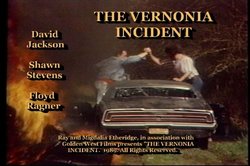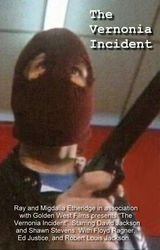"The Vernonia Incident" (1989)
Official fan page and website for the original 1989 production. A full-length feature film, shot in Vernonia Oregon.
"The Vernonia Incident" , also known as "Lynch Mob Vigilantes", is a full-length feature film which was shot in the city of Vernonia Oregon in the spring of 1989. The filmmaker is Ray Etheridge, who graduated from Vernonia High School in 1970. Ray had been working as a cameraman in Los Angeles, and in his spare time he fashioned a script about a robbery in a small, rural town. Vernonia was an easy choice for the movie's location, and once the decision was made to shoot in Vernonia, planning began.
PLANNING
Several months later, Ray made the long drive from Los Angeles to Vernonia, setting up an office in the home of his mother, Emma, who also offered the use of her home as one of the major filming locations. An old 16mm movie camera was purchased from KATU Television in Portland Oregon, which had been used by the news department in the days before video tape. Ads were placed in Vernonia's newspaper, "The Independent", for actors, shooting locations, and crew members. Gordon Smith and Chuck Hendryx agreed to allow filming in their Sentry Market, and made one of their vacant properties available to conduct actor auditions. Auditions were held over a three-day period, and over 70 people were chosen to play parts in the film.
CAMERA CARS
The script required the use of over a dozen "chase cars", which would be purposely "crashed and burned" for the movie. A deal was struck with Ed Biros, who owned the local "auto junk yard", to provide driveable cars, deliver them to the filming location, and then haul them away once the cars had been filmed. Ed also provided one of his flatbed tow trucks to be used as a "camera car", upon which a car could be filmed without actually driving it.
EXPLOSIVES
The script also required a lot of gunshots and explosions, for which a special "powder license" is required. Ray struck a deal with Jim Gardner, whereby Ray would teach Jim some of the "Hollywood tricks" that he had learned, and Jim would be the one to actually handle the explosives. The end result was impressive. Electric "squibs" were attached to actors to simulate gunshot wounds, and a mixture of dynamite and chemical fertilizer was used to "blow-up" the picture cars. Jim also provided a "water truck" which was used to put out the fires that we had set in the cars.
THE "HOSTAGE" FARMHOUSE.
The "exterior" of the farmhouse in which a family is "held hostage" was the home of Bruce and Donna Hepler. The "interior" of the farmhouse was shot in the home of Associate Producer Emma Etheridge. The walls which were "shot to bits" by the angry posse were actually false walls constructed in Emma's garage, which perfectly matched the "real" walls inside her home.
GUNS AND AMMUNITION
Actors were allowed to use their own guns in the film. In many carefully controlled scenes, LIVE ammunition was fired on-cue into targets placed just off-camera. In scenes where gunmen were shooting at buildings or around people, "blank" ammunition was used. Each and every shot was carefully counted and monitored, and safety checks were made after each scene was filmed.
FORMAT and BUDGET
"The Vernonia Incident" was shot on 16mm film, on Kodak 7240/7250 stock. (VNF/Ektachrome). The film was processed by Technifilm in Portland Oregon, where it was transferred to 1-inch video tape for editing. The movie was edited (on tape) at Sunset Post, in Glendale California, and the audio was re-recorded at Future Post in Burbank, California. This "low-budget" film cost $67,000 to produce, of which $40,000 was to shoot the movie, $14,000 to re-record the sound track, and $13,000 for editing.
SOUND TRACK
Due to problems with the film's recording equipment, the original soundtrack was rendered virtually useless, so the entire soundtrack had to be reconstructed from scratch. Eight professional actors were hired in Los Angeles to "voice" all of the performers in the movie, with each doing numerous parts. This practice is known as "looping", or ADR. In addition, all of the sound effects, such as gunshots, door slams, car engines, helicopters, and so on, were all reconstructed by a "foley", or sound effects artist. The entire process of re-building the soundtrack took 5-days, at a cost of around $2800.00 per day.
EDITING
Editing was first done by viewing and "editing" VHS copies of the 1-inch masters. The VHS tapes, and "time-code" notes were then handed over to Sunset Post, which cut the 1-inch masters to match the VHS "paper edit". This process took 3-days, at a cost of approximately $500 per hour, or $4300.00 per day.
To view the trailer, (click here).
To purchase a DVD, (click here)
For Download-to-own, (click here)
Behind-the-scenes (click here)
The "long" original version (click here)
CONTACT RAY and MIGDALIA ETHERIDGE
Email Ray and Migdalia
Movie Review (click here)

